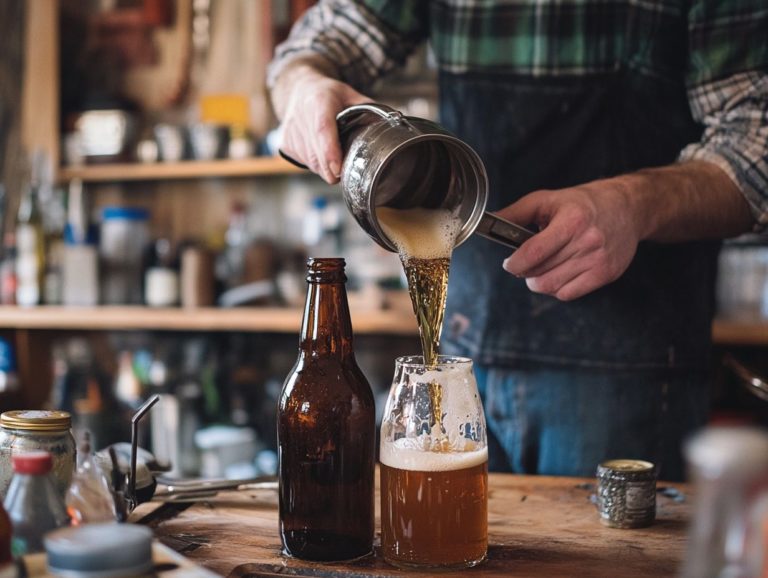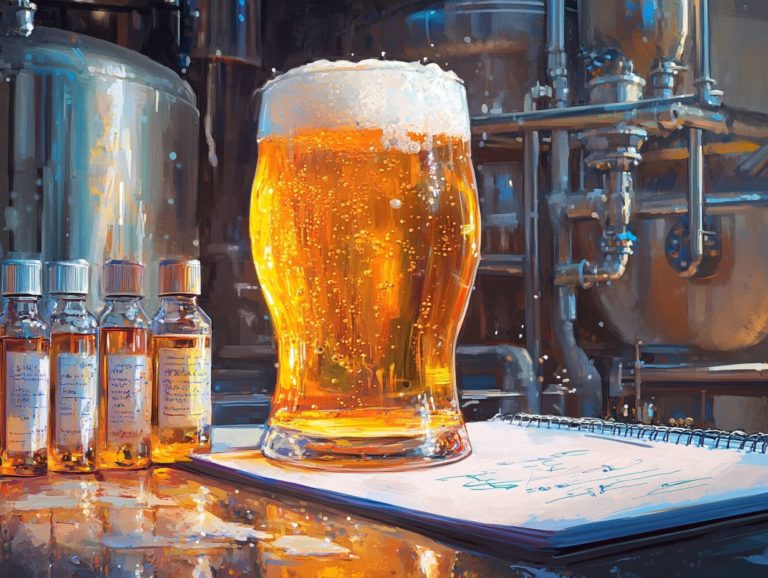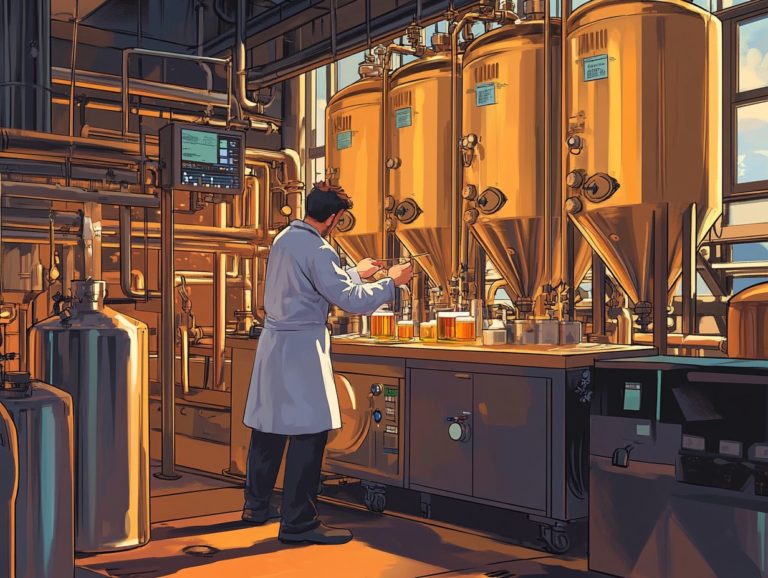5 Essential Tips for Clean Brewing
Brewing is both an art and a science. However, maintaining cleanliness is essential for a rewarding experience and flavor throughout your process.
Here are five crucial tips to ensure a clean brewing experience, from using filtered water to meticulously cleaning your equipment before and after each use. You ll discover the importance of proper ingredient storage, the ideal brewing conditions, and the necessity of regular maintenance.
We ll also tackle common mistakes and provide additional insights to help you maintain a pristine brewing environment. Prepare to elevate your brewing game while keeping your setup impeccably hygienic!
Contents
- Key Takeaways:
- 1. Use Filtered Water
- 2. Clean Equipment Thoroughly Before and After Use
- 3. Store Ingredients Properly
- 4. Follow Recommended Brewing Times and Temperatures
- 5. Regularly Clean and Maintain Brewing Equipment
- Why Is Clean Brewing Important?
- How Often Should Brewing Equipment Be Cleaned?
- What Are the Best Cleaning Methods for Different Types of Brewing Equipment?
- What Are Some Common Mistakes to Avoid When Cleaning Brewing Equipment?
- What Are Some Additional Tips for Maintaining a Clean Brewing Environment?
- Frequently Asked Questions
- What are the 5 essential tips for clean brewing?
- Why is proper equipment cleaning important for clean brewing?
- How does using filtered water contribute to clean brewing?
- Why is accurate ingredient measurement important for clean brewing?
- What role does following recommended brewing times and temperatures play in clean brewing?
- How does sanitizing surfaces and utensils contribute to clean brewing?
Key Takeaways:
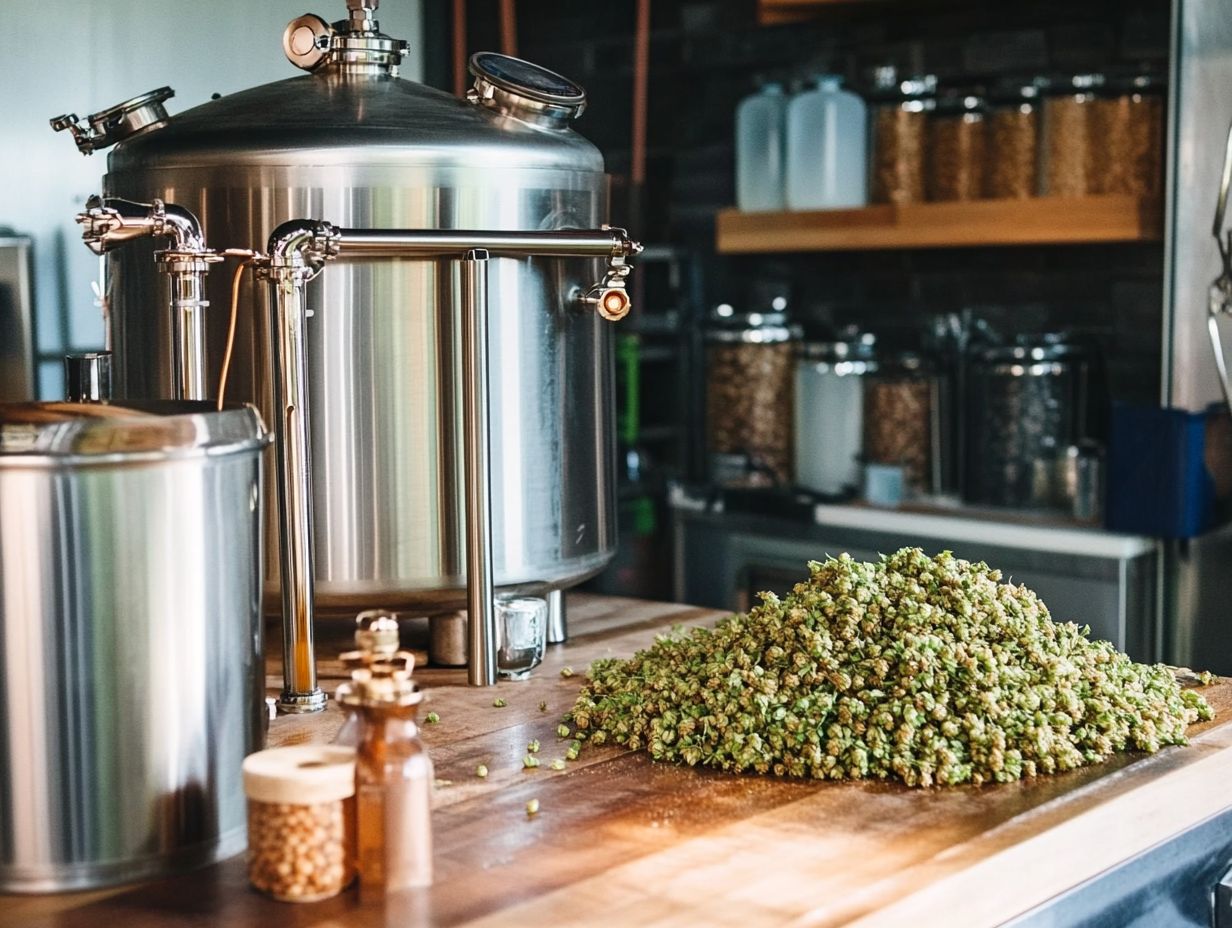
- Use filtered water to ensure the best taste and quality in your brew.
- Thoroughly clean equipment before and after use to prevent contamination.
- Properly storing ingredients prolongs their freshness.
1. Use Filtered Water
Filtered water is essential in the brewing process. It significantly determines the quality of your beer.
By removing dirt, microbes, and contaminants, you protect your brewing equipment and prevent off flavors from sneaking into your final product. A pristine water source upholds your brewery standards and enhances effective sanitation practices.
Impurities in unfiltered water can introduce unwanted flavors and disrupt fermentation, which is vital for unlocking the unique characteristics of each beer style. Explore exciting methods for water purification that can transform your brew, such as reverse osmosis, carbon filtration, and UV sterilization each offering distinct advantages in eliminating specific contaminants.
By adopting a suitable filtration system that caters to your local water supply, you can elevate the overall quality of your brews. Regularly testing water quality and maintaining your filtration equipment is crucial in preventing risks associated with contaminants, ensuring you have a safe and consistent supply for brewing excellence.
2. Clean Equipment Thoroughly Before and After Use
Thoroughly cleaning your brewing equipment before and after use is absolutely essential for cultivating a successful brewing environment. It helps you eliminate leftover residues, bacteria, and biofilms that could disrupt the fermentation process and jeopardize the quality of your beer.
Establishing a comprehensive cleaning process for fermentation tanks, kegs, and draft lines ensures that every component remains free from contaminants that might alter your final product. Using soaps that are strong enough to break down organic matter and stubborn deposits is a must.
Develop a routine that aligns with industry standards. This should include regular checks on your equipment’s condition and confirming that cleaning agents are used at the right concentrations. Incorporating sanitizing steps like rinsing and thorough drying not only preserves the integrity of your brewing equipment but also enhances the overall quality and consistency of the beer you produce.
3. Store Ingredients Properly
Proper storage of your brewing ingredients is essential in achieving a top-notch craft beverage. It ensures that your hops, yeast, and other components remain uncontaminated and effective, preventing unwanted bacteria growth and preserving the integrity of your creation.
The right storage conditions can significantly elevate the quality of your final product. Ideally, hops should be kept in a cool, dark place at temperatures around 32-40 F, with low humidity levels to maintain their potency. Your yeast flourishes best in a stable environment, ideally within the same temperature range, which helps preserve its viability. Utilize food-grade containers, as they minimize the risk of contamination from external elements.
Neglecting these storage practices can lead to off flavors or, worse, a complete failure in fermentation. Ultimately, this could severely compromise the taste and quality of your brew.
4. Follow Recommended Brewing Times and Temperatures
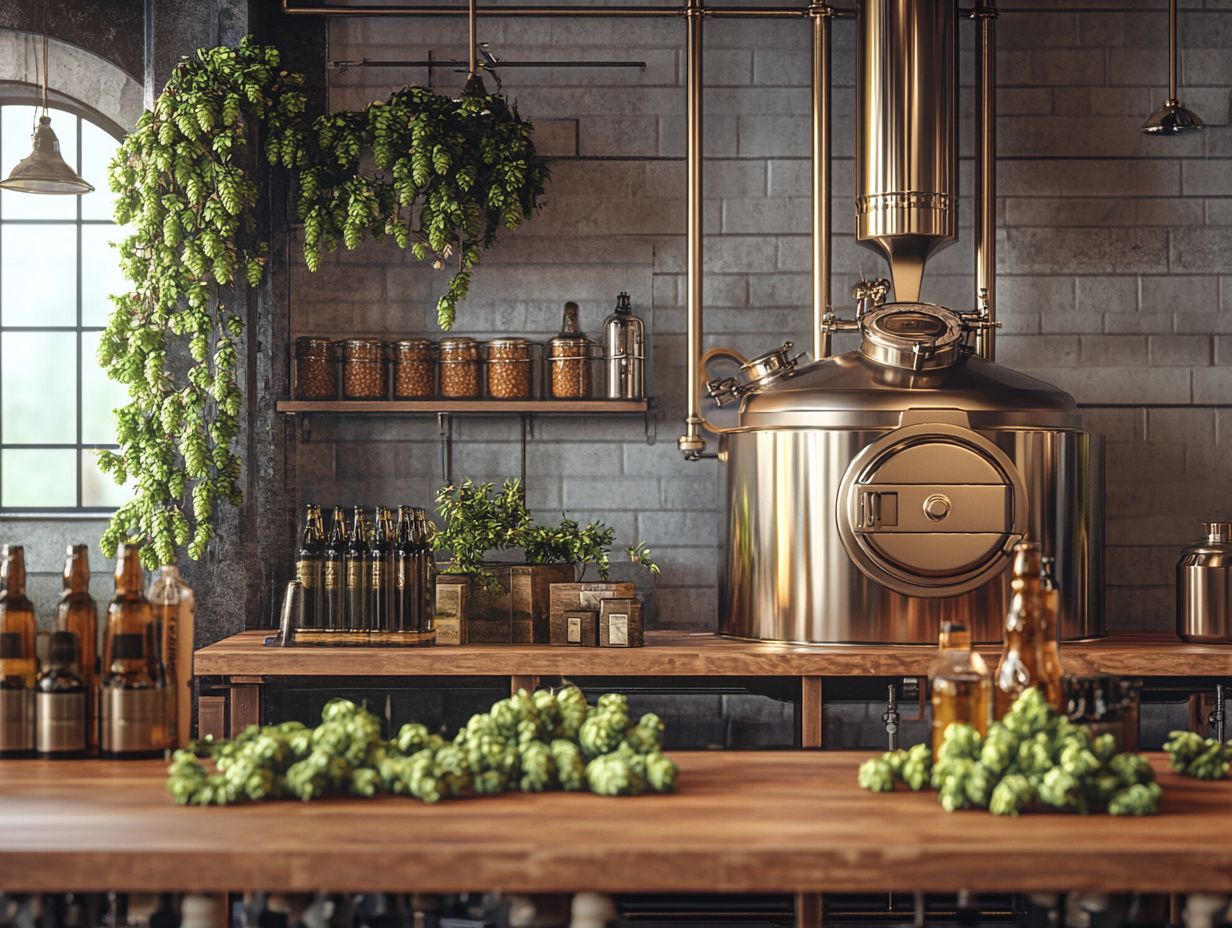
Adhering to the recommended brewing times and temperatures is essential for achieving optimal fermentation results. Deviations from these guidelines can invite undesirable microbes and off-flavors into your beer, which is certainly not the goal.
Precise temperature control at each brewing stage is crucial. It directly affects yeast activity and shapes the final flavor profile. For example, if fermentation temperatures climb too high, the yeast may produce an overload of esters and phenols. This can result in fruity or spicy notes that overshadow the brew’s intended characteristics. Conversely, if temperatures dip too low, sluggish fermentation and incomplete flavor development can occur.
To ensure the best outcomes, regularly monitor and adjust your brewing conditions. Using thermometers and temperature controllers to track changes can make all the difference. Neglecting these critical parameters not only opens the door to off-flavors but also compromises yeast health, leading to inconsistent beer quality.
5. Regularly Clean and Maintain Brewing Equipment
Regular cleaning and maintenance of your brewing equipment are crucial for ensuring long-term effectiveness and safety. When these practices are neglected, dirt, slimy layers of bacteria, and other contaminants can accumulate, jeopardizing the brewing process and potentially undermining your brewery’s standards.
By establishing a cleaning schedule that aligns with your operational demands, you can optimize your processes and cultivate a culture of diligence among your team. Implementing a systematic approach to inspecting and cleaning fermentation tanks and other equipment can significantly mitigate the risk of unexpected breakdowns. Regular checks can reveal early signs of wear or malfunction, enabling you to address issues promptly and avoid the more expensive consequences of delayed repairs.
Setting aside specific days for thorough cleaning, in addition to routine inspections, ensures that all your equipment operates at peak efficiency. This ultimately enhances the quality of the brews you produce.
Why Is Clean Brewing Important?
Clean brewing is essential for upholding the integrity and quality of the beer you produce. By minimizing the risk of contamination from microbes and bacteria, you safeguard the fermentation process, preserve the intended taste, and ensure a safe environment in your brewery.
Maintaining rigorous sanitation protocols enhances the flavor profile of your beers and creates a cleaner, more enjoyable drinking experience. There s a direct correlation between contamination levels and off-flavors; yeast contamination can introduce sour notes that overshadow the flavors you aim to achieve.
Statistics reveal that nearly 30% of all brewery failures stem from poor sanitation practices. This underscores the critical importance of cleanliness. A hygienic brewing environment protects the health of your workers by significantly reducing the risk of harmful bacteria thriving within the facility.
Ultimately, a clean brewing process transcends mere flavor; it reflects on the overall reputation, quality, and safety of the beverages you produce.
What Are the Potential Risks of Not Cleaning Brewing Equipment?
Neglecting to clean your brewing equipment exposes you to a range of risks, including the growth of harmful microbes and bacteria. This not only leads to off-flavors in your beer but can also jeopardize the entire fermentation process.
When you overlook proper cleaning protocols, the likelihood of cross-contamination between batches rises dramatically. This poses a serious threat to the quality and safety of your final product. For instance, a well-known brewery faced a significant decline in customer satisfaction and sales after uncovering a biofilm in their fermentation tanks, resulting in an entire batch being spoiled.
Such scenarios highlight the importance of sticking to established cleaning routines not just to maintain product integrity but also to safeguard your brewery’s reputation in a competitive market. Inadequate sanitation practices can turn a minor oversight into a widespread problem, impacting both the taste of your beer and the trust of your consumers.
How Often Should Brewing Equipment Be Cleaned?

Establishing a regular cleaning schedule for your brewing equipment is essential. Clean your gear immediately after use and conduct routine maintenance to prevent residue buildup. This practice prevents flavor contamination and safeguards the quality of the beer you produce.
Different types of brewing equipment require varying cleaning frequencies based on usage patterns and ingredients. For example, fermenters and kettles, which come into direct contact with wort and yeast, should be cleaned and sanitized after every batch. Grain mills and equipment that handle grains can be cleaned less frequently usually after a couple of batches but keep an eye on them for signs of buildup that could impact flavor.
Best practices recommend creating a detailed cleaning routine that incorporates effective sanitization methods in line with brewery standards. This enhances the taste of your brews and supports the longevity of your equipment.
What Are the Best Cleaning Methods for Different Types of Brewing Equipment?
Different types of brewing equipment require tailored cleaning methods to eliminate dirt, residues, and potential contaminants, ensuring that every piece of equipment, from fermentation tanks to draft lines, remains safe for use. This meticulous cleaning process is essential for maintaining the integrity of your brewing environment and safeguarding the flavors of your final product.
For cleaning fermentation tanks, using a caustic cleaner is key to breaking down organic matter, followed by a thorough rinse with hot water. Cleaning beer lines often requires a type of cleaner that removes mineral buildup.
Follow these steps to clean your brewing lines effectively:
- Start by disconnecting the lines.
- Run the cleaning solution through them.
- Finally, flush with clean water to eliminate any lingering residue that might alter taste or quality.
Each cleaning method promotes hygiene and enhances your overall brewing experience.
What Are Some Common Mistakes to Avoid When Cleaning Brewing Equipment?
Common mistakes during the cleaning process can lead to inadequate sanitation, allowing harmful bacteria to flourish and potentially spoiling your precious batches of beer. These missteps often arise from insufficient rinsing and using inappropriate cleaning agents, leading to residue buildup that can harm both your equipment and the final product.
As a brewmaster, ensure that all surfaces are meticulously rinsed, as any leftover sanitizer can disrupt the brewing process. Choosing the right cleaning agents is essential; use products specifically formulated for brewing equipment to enhance efficacy and reduce potential risks. Additionally, consider these 5 tips for optimizing your brew day to streamline your process further.
Establish a cleaning protocol now to ensure your brewing success. Include a detailed checklist, regular equipment inspections, and ongoing training for your staff to reinforce best practices and maintain consistently high sanitation standards. Additionally, consider incorporating quick tips for efficient home brewing to enhance your process.
What Are Some Additional Tips for Maintaining a Clean Brewing Environment?
Maintaining a pristine brewing environment requires strategies that go beyond mere cleaning routines. Regular inspections, proper ingredient storage, and effective cleaning agents are essential to minimizing contamination risks.
A crucial element of this process involves ensuring that every staff member is thoroughly trained in best sanitation practices. This gives them the power to identify potential hazards and fosters a sense of responsibility for cleanliness throughout the workspace.
Implementing specialized brewery wash systems can significantly enhance the efficiency and effectiveness of your cleaning procedures. By integrating these systems into your daily operations, you can guarantee comprehensive sanitation of your equipment and surfaces.
Cultivating a culture of cleanliness among your staff prioritizes quality and safety, leading to improved product integrity and building consumer trust.
By implementing these cleaning practices, you ll achieve better brewing results and ensure the quality of your beer.
Frequently Asked Questions
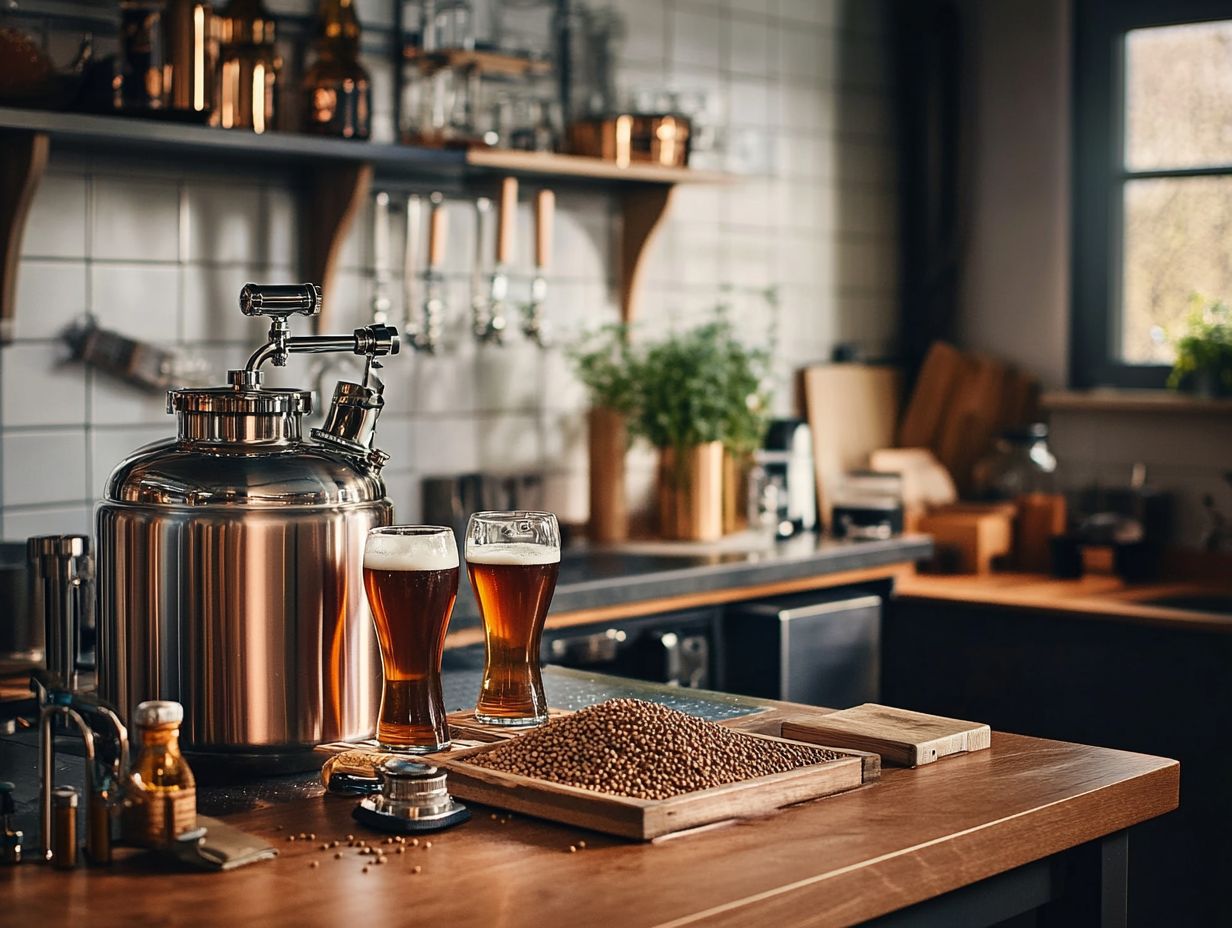
What are the 5 essential tips for clean brewing?
The 5 essential tips for clean brewing are proper equipment cleaning, using filtered water, and measuring ingredients accurately. Following recommended brewing times and temperatures and sanitizing all surfaces and utensils is also crucial.
Why is proper equipment cleaning important for clean brewing?
Clean equipment is crucial for clean brewing. Any leftover residue or bacteria can affect the taste and quality of the final brew. Always clean and sanitize your brewing equipment before and after use to ensure a fantastic brew!
How does using filtered water contribute to clean brewing?
Using filtered water removes impurities and chemicals that can alter the brew’s taste. It also helps prevent potential contamination from tap water that may affect the brewing process and final product.
Why is accurate ingredient measurement important for clean brewing?
Accurate ingredient measurement ensures that the brew is balanced and consistent. Too much or too little of an ingredient can affect the flavor and quality of the brew.
What role does following recommended brewing times and temperatures play in clean brewing?
Brewing times and temperatures are crucial for extracting the desired flavors and aromas from the ingredients. Following the recommended times and temperatures ensures that the brew is properly brewed and free from any under or over-extraction.
How does sanitizing surfaces and utensils contribute to clean brewing?
Sanitizing means cleaning to eliminate any harmful bacteria. It eliminates potential bacteria or contaminants that may affect the brew. Regularly sanitize all surfaces and utensils to maintain a clean brewing environment.


